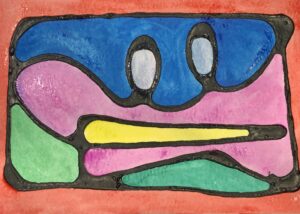 At a recent Diocese of West Texas ECW gathering, Rev. Beth Wyndam of St. Nicholas Church in Bulverde, Texas, spoke regarding her passion for praying in color. God called her to plant a church based on joy. Trusting in joy, she embraced the grace of imperfection, cultivating creativity and finding God in new ways. She started teaching how to pray in color to increase faith.
At a recent Diocese of West Texas ECW gathering, Rev. Beth Wyndam of St. Nicholas Church in Bulverde, Texas, spoke regarding her passion for praying in color. God called her to plant a church based on joy. Trusting in joy, she embraced the grace of imperfection, cultivating creativity and finding God in new ways. She started teaching how to pray in color to increase faith.
What is prayer? Prayer is a conversation with God that God initiates in creation. It can be as simple as smiling at a person, journaling or praying while coloring. Obstacles to prayer are our daily lives, business, time, the phone, anxiety, forgetting to pray, needing to make prayers perfect, feeling like we’re not good enough to pray or that it needs to be done in a certain way (like on our knees).
Rev. Wyndam asked when or where had we had a moving prayer experience. How do you best hear God? Is it easy or hard for you to share your prayer life with others? It’s important to know we’re not alone and the power we hold in prayer. Praying in color helps us to pray for people who are uncomfortable with prayer.
Praying in Color: Drawing a New Path to God is authored by Sybil MacBeth. Her book describes how by doodling and praying while coloring she found a new outlet to reach God with her prayers. Why would one want to pray in color? You may want to pray but can’t find the right words. If sitting still and focusing are not your thing, praying in color may be a creative way to pray. It offers a concrete way to connect with God. It allows us to slow down and listen to God.
You do not have to be an artist to pray in color. You can begin by just doodling by drawing shapes over and over again such as swirls, hearts, tails, drops, waves, spirals, pyramids, or dots. Then add lines. Next, add names, issues or words and then color the doodles using colored pencils, watercolors or markers. You can use any type of prayer when praying in color such as adoration, confession, intercession, petition or thanksgiving.
You can also use Lectio Divina to pray in color. After hearing a scripture passage read two to three times, mediate on one word from the reading. Use this word as your center for praying in color.
Thinking through our color choices can help us bring scripture to life and draw closer to God. Red, yellow and blue are colors found all around us—in nature, in our lives, and in our scripture.
Red
The Israelites painted the blood of a Passover lamb offering in order for the angel of death to pass over their homes during the tenth and final plague of Egypt (Exodus 12:1-13).
Red is also associated with the blood of Jesus Christ for the love shared on the cross at Calvary (Colossians 1:20).
Red is the color of fire, passion and love.
Red is used to symbolize Christ’s passion during Holy Week and the gift of the Holy Spirit on Pentecost Sunday.
Blue
Blue is translated in Hebrew as tekelet. Tekelet was the color assigned for priests’ clothing; in particular, their hems (Exodus 28:5-6).
The woman in need of healing in Luke 8:40-48 touched the hem of Jesus’ garment and she was healed. Blue is often seen as being a color for healing and grace.
Blue also represents the heavens and the Word of God. In Exodus, when Moses, his sons, and 70 elders of Israel went up to Mount Sinai to worship God, they saw God and described the pavement under his feet as being as bright as the blue sky (Exodus 24:10).
First scripture reference—These are the offerings you are to receive from them: gold, silver and bronze; blue, purple and scarlet yarn and fine linen: goat hair; ram skins dyed red and another type of durable leather; acacia wood (Exodus 25:3-5).
Yellow
Yellow is referenced in the Bible by the Hebrew word charuts, which refers to gold.
Gold often represents the sovereignty of God. In the Old Testament, Solomon had the Temple built and overlaid in gold, even down to the priest’s utensils (1 Kings 6).
At Jesus’ birth, one of the gifts He received was gold (Matthew 2:11).
Additionally, in the book of Revelation, the New Jerusalem is referred to as a city of pure gold (Revelation 21:18).
Actual scripture references of the color yellow (three of them) talk about hair turning yellow from sickness.
The fourth references the feathers of a dove.
Other colors in our tradition include purple, white and green.
Purple
Purple is the color of royalty and penitence, of wisdom, creativity and nobility.
Purple is used during periods of preparation, repentance and reflection: Advent, the season before Christmas, and Lent, the season before Easter.
White
White is the color of joy and celebration, of renewal and cleaning. It represents purity and goodness and hope.
In the church year, white is used during seasons of celebration—Christmas/Epiphany and Easter—and on special Sundays, like Transfigurations Sunday, Trinity Sunday, All Saints’ Day and the Reign of Christ Sunday.
Green
Green is the color of growth and new life.
We use this color the most throughout the church year—all during Ordinary Time. It’s a time of growth and learning and community and moving forward.
You may consider colors that appeal to your senses. What colors bring you calm? What colors bring you strength? What colors energize you and revive you?
Many thanks to Rev. Beth, for her insights and enthusiasm fr praying in color.
For downloadable patterns to color, please visit www.chubbymermaidart.com.
 By Lisa Bortner
By Lisa Bortner
